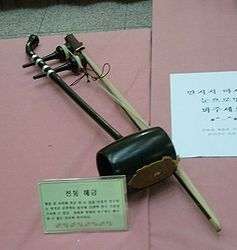
Haegeum
The haegeum (Hangul: 해금) is a traditional Korean string instrument, resembling a fiddle. It is popularly known as kkangkkangi. It has a rodlike neck, a hollow wooden soundbox, and two silk strings, and is held vertically on the knee of the performer and played with a bow.
The haegeum is one of the most widely used instruments in Korean music. The haegeum is used in court music as well as madangnori (ordinary people's music). The haegeum's range of expression is various despite having only two strings, with sounds ranging from sorrowful and sad to humorous. The haegeum is made using eight materials: gold, rock, thread, bamboo, gourd, soil, leather, and wood, and so it is called paleum (eight sounds).
The sohaegeum (소해금) is a modernized fiddle with four strings, used only in North Korea.photo
History
There are no records about the exact era when the haegeum was first introduced in Korea. According to several sources, references to the haegeum can be found in hanlimbyeolgok (the unrhymed verse and songs of the royal scholars) made in the Goryeo dynasty, so it can be inferred that the haegeum has been played at least since then.

